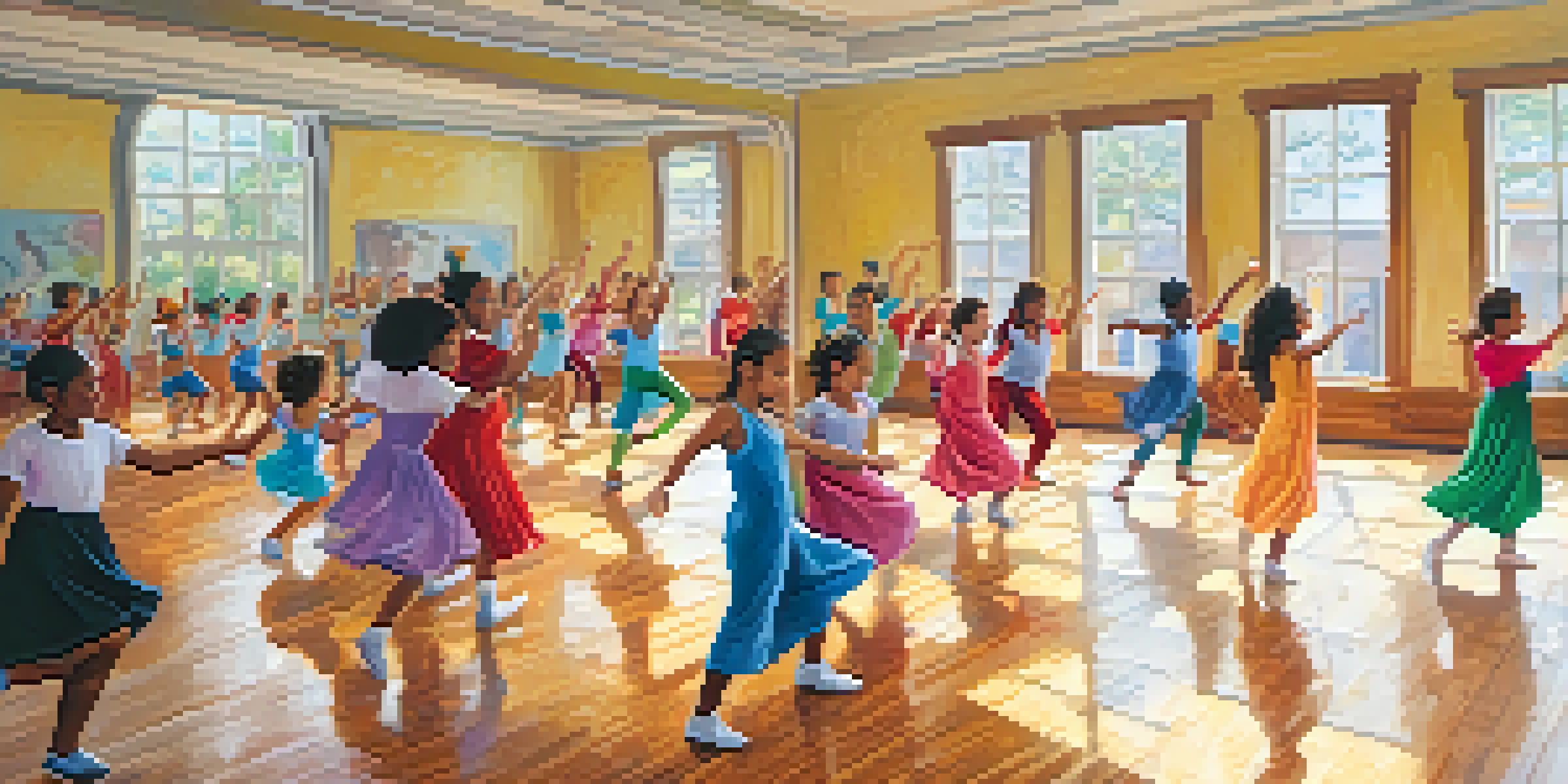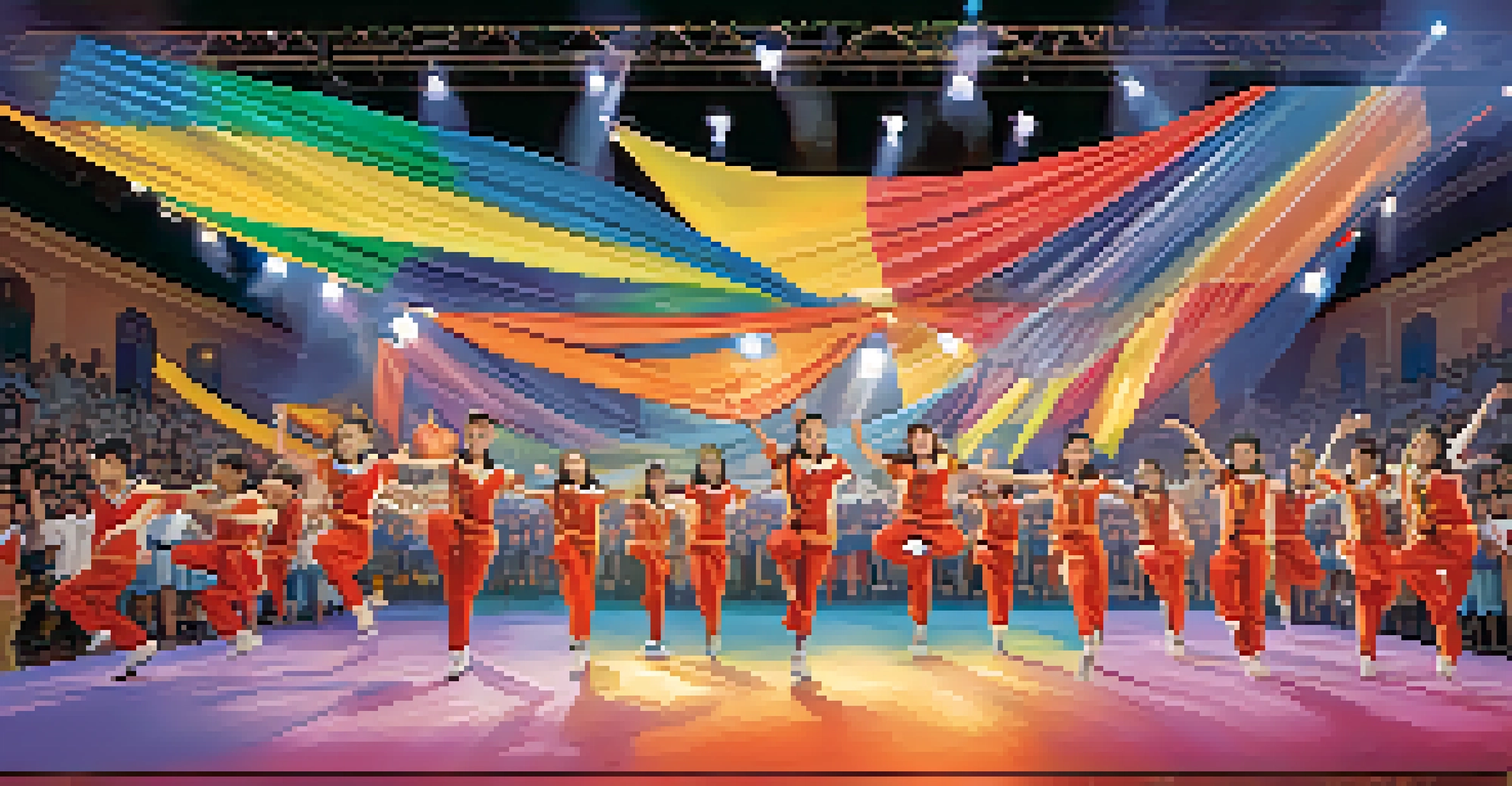The Psychological Benefits of Dance in Educational Settings

Dance as a Tool for Emotional Expression in Students
Dance provides a unique outlet for students to express their emotions. Whether they are feeling joy, sadness, or excitement, movement allows them to convey feelings that words often can't capture. This emotional expression can be particularly beneficial for young people who may struggle with verbal communication.
Dance is the hidden language of the soul.
By engaging in dance, students learn to recognize and manage their emotions better. This self-awareness fosters a sense of control and can lead to improved emotional regulation. Furthermore, sharing dance with peers can create a supportive atmosphere where students feel safe to express themselves.
Ultimately, dance nurtures emotional intelligence in students, equipping them with essential skills for navigating life's challenges. As they learn to express and manage their feelings, they also cultivate empathy towards others, contributing to a more harmonious classroom environment.
Boosting Self-Esteem Through Dance Activities
Participating in dance can significantly boost a student's self-esteem. As they learn new moves and overcome challenges, they gain a sense of accomplishment that builds confidence. This newfound self-assurance can spill over into other areas of their lives, such as academics and social interactions.

Moreover, dance encourages individuality and self-acceptance. In a dance class, students can explore their unique styles and find their voices, which helps them embrace who they are. This acceptance promotes a positive self-image, making them feel good about themselves.
Dance Boosts Emotional Expression
Engaging in dance allows students to express and manage their emotions, fostering self-awareness and empathy.
When students feel good about their abilities and who they are, they are more likely to take risks and try new things. This willingness to step outside their comfort zone can lead to personal growth, fostering resilience and a can-do attitude that benefits them both in and out of the classroom.
Fostering Social Connections Through Group Dance
Group dance activities are a fantastic way for students to forge social connections. As they learn choreography together or participate in dance teams, they develop a sense of camaraderie and teamwork. These shared experiences create lasting friendships and a supportive network among peers.
Dancing is like dreaming with your feet!
Collaborative dance projects also promote communication skills. Students must work together, share ideas, and provide feedback, honing their ability to express themselves clearly and listen to others. This practice in collaboration can enhance their overall social skills, making them more effective communicators.
Additionally, the inclusive nature of dance fosters a welcoming environment for students from diverse backgrounds. When everyone comes together to dance, it breaks down social barriers, allowing students to appreciate each other's differences and build a stronger sense of community.
Enhancing Cognitive Function Through Dance Education
Engaging in dance has been shown to enhance cognitive function in students. The combination of physical movement and rhythm stimulates brain activity, improving memory, attention, and problem-solving skills. This mental engagement can lead to better academic performance in other subjects.
Furthermore, learning dance routines requires memorization and coordination, which challenges the brain in unique ways. Students must remember sequences, count beats, and synchronize movements, all of which contribute to cognitive development. This engagement can sharpen their overall learning abilities.
Dance Enhances Physical Health
Regular participation in dance promotes physical fitness, leading to improved energy levels and overall well-being.
Incorporating dance into education encourages a holistic approach to learning, where physical and intellectual growth go hand in hand. As students experience the benefits of improved cognitive function, they become more motivated to engage in their studies and explore new subjects.
Reducing Stress and Anxiety Through Dance
Dance serves as an effective stress-reliever for students facing academic pressure and social challenges. Physical movement releases endorphins, the body's natural mood lifters, helping to alleviate feelings of anxiety and promote relaxation. This can be particularly beneficial during stressful times, such as exams or project deadlines.
Additionally, dance encourages mindfulness as students focus on their movements and rhythm. This present-moment awareness can help them step away from their worries and immerse themselves in a positive activity. The rhythmic nature of dance can also have a calming effect on the mind.
As students learn to manage their stress through dance, they develop valuable coping strategies they can use throughout their lives. This ability to handle stress effectively contributes to their overall well-being, allowing them to thrive both academically and personally.
Promoting Physical Health and Well-Being with Dance
Beyond its psychological benefits, dance also promotes physical health, which is closely linked to mental well-being. Regular physical activity through dance helps students maintain a healthy weight, improve cardiovascular fitness, and enhance overall physical strength and coordination. This active lifestyle can lead to increased energy levels and better focus in school.
Moreover, dance helps instill healthy habits at a young age. When students see the connection between physical activity and well-being, they are more likely to carry these habits into adulthood. This proactive approach to health can lead to a lifetime of wellness and reduced risk of chronic illnesses.
Dance Fosters Social Connections
Group dance activities cultivate teamwork and communication skills, helping students build lasting friendships and a sense of community.
By incorporating dance into educational settings, schools can encourage students to embrace a physically active lifestyle. This commitment to health not only benefits their bodies but also enhances their mental resilience, creating a well-rounded approach to education.
Cultivating Discipline and Commitment Through Dance
Participating in dance requires dedication and discipline, traits that are invaluable for students. As they practice and perfect their skills, they learn the importance of hard work and perseverance. This commitment to improvement can translate to other areas of their lives, fostering a strong work ethic.
Additionally, the structured nature of dance classes helps students develop time management skills. Balancing practice schedules with schoolwork teaches them how to prioritize tasks effectively. This skill set is essential for academic success and prepares them for future responsibilities.

Ultimately, the discipline cultivated through dance empowers students to set goals and strive for achievement. As they learn to navigate challenges and celebrate successes, they build a resilient mindset that prepares them for life beyond the classroom.
Creating a Positive School Culture with Dance
Incorporating dance into the school environment can significantly contribute to a positive culture. When students participate in dance, they engage in a shared experience that fosters unity and school spirit. This sense of belonging can enhance overall satisfaction and motivation within the student body.
Moreover, dance encourages creativity and self-expression, which are key components of a vibrant school culture. When students feel free to express themselves through movement, they are more likely to engage actively in their learning environment. This engagement can lead to increased participation and enthusiasm in school activities.
Ultimately, a positive school culture nurtured by dance can lead to improved student outcomes. As students feel connected, supported, and inspired, they are more likely to succeed academically and develop into well-rounded individuals ready to contribute positively to their communities.